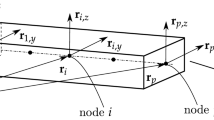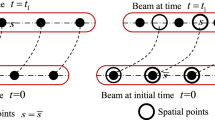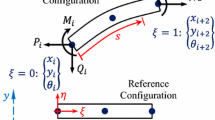Abstract
This paper presents an efficient mesh updating scheme (MUS) for the arbitrary Lagrangian–Eulerian (ALE) formulation of an arbitrarily curved beam based on the corotational method. By discretizing the beam using both Lagrangian elements and ALE elements, the proposed MUS can take full advantage of the simple expression form of the Lagrangian formulation and the accurate moving-load description of the ALE node. The deleting-node and adding-node procedures of the MUS can avoid the negative influence of the variation of the ALE element length on the element accuracy and stiffness matrix singularity. In contrast to the adding-node procedure for Lagrangian elements, interpolation cannot be used directly. Inserting a Lagrangian node in an ALE element is investigated, and the displacement, velocity, and acceleration of the newly added node are evaluated accurately based on the corotational method. Three examples are investigated to verify the validity, computational accuracy and computational efficiency of the proposed MUS by comparing the results of the MUS with those from literature that utilized traditional ALE formulation. These examples show that the proposed MUS has significant advantages in terms of computational time and computer memory.






Similar content being viewed by others
Availability of Data and Materials
The datasets used or analyzed during the current study are available from the corresponding author upon reasonable request.
References
Sun X, Xu M, Zhong R. Dynamic analysis of the tether transportation system using absolute nodal coordinate formulation. Acta Astronaut. 2017;139:266–77.
Shi G, Li G, Zhu Z, Zhu ZH. A virtual experiment for partial space elevator using a novel high-fidelity FE model. Nonlinear Dyn. 2019;95:2717–27.
Szyłko-Bigus O, Śniady P, Zakęś F. Application of Volterra integral equations in the dynamics of a multi-span Rayleigh beam subjected to a moving load. Mech Syst Signal Process. 2019;121:777–90.
Li SH, Ren JY. Analytical study on dynamic responses of a curved beam subjected to three-directional moving loads. Appl Math Model. 2018;58:365–87.
Wu Q, Wang X, Hua L, et al. Modeling and nonlinear sliding mode controls of double pendulum cranes considering distributed mass beams, varying roped length and external disturbances. Mech Syst Signal Process. 2021;158:107756.
Zhang YW, Hou S, Xu KF, Yang TZ, Chen LQ. Forced vibration control of an axially moving beam with an attached nonlinear energy sink. Acta Mech Solida Sin. 2017;30:674–82.
Tang YQ, Zhang YX, Yang XD. On parametric instability boundaries of axially moving beams with internal resonance. Acta Mech Solida Sin. 2020;33(2):150–63.
Yan T, Yang TZ, Chen LQ. Direct multiscale analysis of stability of an axially moving functionally graded beam with time-dependent velocity. Acta Mech Solida Sin. 2018;31(4):470–83.
Zhang P, Ma J, Duan M, et al. A high-precision curvature constrained Bernoulli-Euler planar beam element for geometrically nonlinear analysis. Appl Math Comput. 2021;397:125986.
Wang G, Qi Z, Xu J. A high-precision co-rotational formulation of 3D beam elements for dynamic analysis of flexible multibody systems. Comput Methods Appl Mech Eng. 2020;360:112701.
Deng LF, Niu MQ, Xue J, Chen LQ. A two-dimensional corotational curved beam element for dynamic analysis of curved viscoelastic beams with large deformations and rotations. Int J Numer Meth Eng. 2023;7(15):1564–84.
Liu JP, Cheng ZB, Ren GX. An Arbitrary Lagrangian–Eulerian formulation of a geometrically exact Timoshenko beam running through a tube. Acta Mech. 2018;229:3161–88.
Han S. Configurational forces and geometrically exact formulation of sliding beams in non-material domains. Comput Methods Appl Mech Eng. 2022;395:115063.
Deng LF, Zhang Y, Chen L. An arbitrary Lagrangian–Eulerian formulation of two-dimensional viscoelastic beams based on the consistent corotational method. J Comput Nonlinear Dyn. 2022;17:071001.
Deng LF, Niu MQ, Xue J, et al. An ALE formulation for the geometric nonlinear dynamic analysis of planar curved beams subjected to moving loads. Mech Syst Signal Process. 2023;184:109670.
Fotland G, Haugen B. Numerical integration algorithms and constraint formulations for an ALE-ANCF cable element. Mech Mach Theory. 2022;170:104659.
Sun J, Tian Q, Hu H, et al. Axially variable-length solid element of absolute nodal coordinate formulation. Acta Mech. 2019;35(3):653–63.
Ding Z, Ouyang B. A variable-length rational finite element based on the absolute nodal coordinate formulation. Machines. 2022;10:174.
Qi ZH, Wang J, Wang G. An efficient model for dynamic analysis and simulation of cable-pulley systems with time-varying cable lengths. Mech Mach Theory. 2017;116:383–403.
Peng Y, Wei Y, Zhou M. Efficient modeling of cable-pulley system with friction based on arbitrary-Lagrangian–Eulerian approach. Appl Math Mech-English Ed. 2017;38:1785–802.
Escalona JL. An arbitrary Lagrangian–Eulerian discretization method for modeling and simulation of reeving systems in multibody dynamics. Mech Mach Theory. 2017;112:1–21.
Luo CQ, Sun JL, Wen H, et al. Dynamics of a tethered satellite formation for space exploration modeled via ANCF. Acta Astronaut. 2020;177:882–90.
Zhang H, Zhao Z, Ren G, et al. Arresting-cable system for robust terminal landing of reusable rockets. J Spacecr Rocket. 2020;58(2):1–19.
Zhang H, Guo JQ, Liu JP, et al. An efficient multibody dynamic model of arresting cable systems based on ALE formulation. Mech Mach Theory. 2020;151:103892.
Grundl K, Schindler T, Ulbrich H, et al. ALE beam using reference dynamics. Multibody SysDyn. 2019;46:127–46.
Steinbrecher I, Humer A, Vu-Quoc L. On the numerical modeling of sliding beams: a comparison of different approaches. J Sound Vib. 2017;408:270–90.
Deng LF, Zhang Y. A consistent corotational formulation for the nonlinear dynamic analysis of sliding beams. J Sound Vib. 2020;476:115298.
Yang S, Hu H, Mo G, et al. Dynamic modeling and analysis of an axially moving and spinning Rayleigh beam based on a time-varying element. Appl Math Model. 2021;95:409–34.
Deng LF, Kennedy D, Zhang Y. Dynamics of 3D sliding beams undergoing large overall motions. Commun Nonlinear Sci Numer Simul. 2021;98: 105778.
Humer A, Steinbrecher I, Vu-Quoc L. General sliding-beam formulation: a non-material description for analysis of sliding structures and axially moving beams. J Sound Vib. 2020;480:115341.
Deng LF, Zhang Y. Nonlinear dynamic analysis of arresting gears using 2D non-material variable-domain corotational elements. Mech Mach Theory. 2021;163:104377.
Le TN, Battini JM, Hjiaj M. A consistent 3D corotational beam element for nonlinear dynamic analysis of flexible structures. Comput Methods Appl Mech Eng. 2014;269:538–65.
Reddy JN. On locking-free shear deformable beam finite elements. Comput Methods Appl Mech Eng. 1997;149(1–4):113–32.
Le TN, Battini JM, Hjiaj M. Efficient formulation for dynamics of corotational 2D beams. Comput Mech. 2011;48(2):153–61.
Yuh J, Young T. Dynamic modeling of an axially moving beam in rotation: simulation and experiment. J Dyn Syst Meas Contr. 1991;113(1):34–40.
Park S, Yoo HH, Chung J. Vibrations of an axially moving beam with deployment or retraction. AIAA J. 2013;51(3):686–96.
Acknowledgements
This work was supported by the Guangdong Basic and Applied Basic Research Foundation (2022A1515110856) and the National Natural Science Foundation of China (Project Nos. 62188101 and 12132002).
Author information
Authors and Affiliations
Contributions
LD: Conceptualization, Methodology, Software, Validation, Formal analysis, Investigation, and Writing-original draft; MN: Validation and Writing-review & editing; YF: Validation and Writing-review & editing; LC: Conceptualization, Supervision, Validation, Writing-review & editing, and Funding acquisition.
Corresponding author
Ethics declarations
Conflict of interest
The authors declare that they have no conflict of interest.
Ethical Approval and Consent to Participate
This study do not involve any sensitive information, and there are no ethical issues.
Consent for Publication
All authors agree on the publication of the manuscript.
Appendix A
Appendix A
This section is devoted to the derivation of \({{\varvec{H}}}_{1}\), \({{\varvec{H}}}_{2}\), \({{\varvec{H}}}_{3}\), \({H}_{4}\), \({\dot{{\varvec{H}}}}_{1}\), \({\dot{{\varvec{H}}}}_{2}\), \({\dot{{\varvec{H}}}}_{3}\) and \({\dot{H}}_{4}\). Investigate first the variation of \(\overline{{\varvec{q}} }\). Considering the approximation in Eq. (11) and using Eqs. (2), (3) and (8), the variation of \({l}_{\mathrm{c}}\) can be obtained as
where \({\varvec{I}}\) denotes a \(2\times 2\) identity matrix. Then, from Eq. (5), the variation of \(\overline{u }\) can be obtained as
Using Eqs. (2), (3) and (A1), the variations of \({\varvec{a}}\) and \(\beta \) can be expressed as
with
Taking the variation of \(\overline{{\varvec{q}} }\) and using Eqs. (4), (5), (11) and (A2)–(A4), one obtains
with
Using Eqs. (2), (10), and (A4), the time derivative of \({{\varvec{R}}}_{\mathrm{r}}\) can be expressed as
Taking the time derivative of Eq. (9) and using Eqs. (8), (11), (A6) and (A8), the terms \({{\varvec{H}}}_{1}\) and \({{\varvec{H}}}_{2}\) in Eq. (13) can be obtained as
where \(\dot{\overline{{\varvec{q}}} }\) can be obtained from (A6). Further, take the time derivative of \({{\varvec{H}}}_{1}\) and \({{\varvec{H}}}_{2}\), one obtains
where \(\dot{{\varvec{a}}}\) can be obtained from Eq. (A3). The first-time derivative and second-time derivative of the shape function matrix can be obtained using Eq. (8), i.e.,
\({\dot{{\varvec{G}}}}_{3}\) and \({\dot{G}}_{4}\) can be obtained using Eq. (A5), i.e.,
where \({\dot{l}}_{\mathrm{c}}\) can be obtained from (A1).
Taking the time derivative of Eq. (12) and using Eqs. (A4) and (A6), the terms \({{\varvec{H}}}_{3}\) and \({H}_{4}\) in Eq. (14) can be obtained as
Further, taking the time derivative of \({{\varvec{H}}}_{3}\) and \({H}_{4}\), one obtains
Rights and permissions
Springer Nature or its licensor (e.g. a society or other partner) holds exclusive rights to this article under a publishing agreement with the author(s) or other rightsholder(s); author self-archiving of the accepted manuscript version of this article is solely governed by the terms of such publishing agreement and applicable law.
About this article
Cite this article
Deng, L., Niu, MQ., Fan, Y. et al. Efficient Mesh Updating Scheme for the ALE Corotational Formulation of an Arbitrarily Curved Beam. Acta Mech. Solida Sin. 36, 647–657 (2023). https://doi.org/10.1007/s10338-023-00406-y
Received:
Revised:
Accepted:
Published:
Issue Date:
DOI: https://doi.org/10.1007/s10338-023-00406-y




